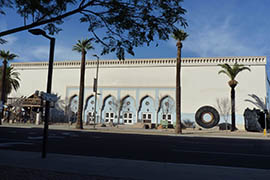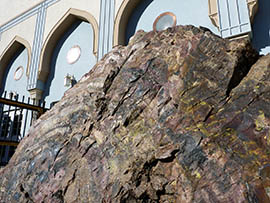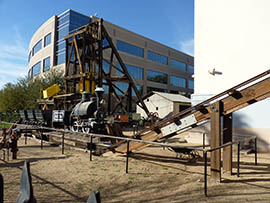Cronkite News has moved to a new home at cronkitenews.azpbs.org. Use this site to search archives from 2011 to May 2015. You can search the new site for current stories.
Lawmaker seeks to reopen Arizona Mining and Mineral Museum
Editor’s Note: The bill featured in this study wasn't taken up in committee during the 2014 legislative session.
PHOENIX – For three years, most of the rocks, gems and artifacts once displayed by the Arizona Mining and Mineral Museum have remained unseen.
Meanwhile, efforts to create a centennial-themed museum in its former space near the State Capitol have stalled for lack of funding.
Saying the old museum should never have been closed in the first place, a state lawmaker has introduced legislation to bring it back.
“I think it was an experiment gone bad by a couple individuals who thought about changing the museum into something else, and now it lies dormant with nothing going on,” said Sen. Eddie Ableser, D-Tempe, author of SB 1023.
Ableser has introduced a bill to reopen the museum every year since it had to shutter its doors in April 2011.
In 2010, Gov. Jan Brewer presented plans for an Arizona Centennial Museum, which would occupy the Mining and Mineral Museum’s renovated space and showcase Arizona’s Five C’s: cattle, copper, cotton, citrus and climate.
It was with this intention that the Legislature transferred responsibility for the museum and the state’s mineral collection from the Department of Mines and Minerals to the Arizona Historical Society.
Brewer assigned the Arizona Centennial Commission to raise money for the new interactive museum by approaching businesses, with fundraising goals set between $9 million and $15 million.
But the commission never raised enough money to move beyond the planning phase. After Arizona’s centennial came and went, the proposed museum’s name changed to the Arizona Experience Museum.
Brewer’s press office didn’t respond to calls and emails seeking comment on the bill. Karen Churchard, director of the Arizona Centennial Commission, was out of the office until Monday, Jan. 27, according a person who responded to a message left with the Arizona Office of Tourism.
Ableser’s bill, which had yet to be scheduled for a committee hearing, would transfer responsibility for the museum from the Arizona Historical Society to the Arizona Geological Survey, which absorbed the Department of Mines and Mineral Resources’ duties in 2011.
Ray Grant, a retired geology professor at Mesa Community College and co-author of “Mineralogy of Arizona,” said closing the museum prevented people from learning about a profession vital to Arizona’s fabric as a state.
“To me it’s one of the greatest geologic states ever. Millions of people come to the Grand Canyon. What’s it about? It’s all geology, isn’t it?” he said.
Former Rep. Russ Jones, R-Yuma, who authored the 2010 legislation transferring responsibility for the museum and its collection, said low revenue and high rent made the old Mining and Mineral Museum unsustainable.
“The museum portion was very, very popular. Unfortunately, the revenues from the activity as a museum were just a fraction of the cost of maintaining and paying the rents on that facility,” he said.
The rent for the old building is still paid for by the state. According to a report by the Joint Legislative Budget Committee, the fiscal 2014 budget provides $428,000 to the Arizona Historical Society, $360,800 of it for rent on the unused museum space and $67,500 for a curator to care for the state’s mineral specimens.
Saying it’s unfortunate that the commission couldn’t raise enough funds for a centennial museum, Jones said Ableser’s legislation would only cause more problems. The Arizona Geological Survey would require a huge sum of money and an increase in staffing to restore the museum, he added.
“There’s so much we need to do that remains undone as we crawl out of the recession, I find it hard to justify millions of dollars for a mining museum when need to fund things for Child Protective Services, the list goes on and on,” Jones said.
Ableser’s bill doesn’t include any appropriation for bringing the museum back.
The collection from the former museum currently consists of more than 21,500 specimens and objects, according to the Arizona Historical Society’s website.
Even if Ableser’s legislation doesn’t succeed, people can see several of the state’s minerals on display at the University of Arizona Mineral Museum, including a 225-pound azurite boulder from Bisbee.
Other minerals will be part of a new Gallery of Natural History opening soon at the Arizona Historical Society’s Museum at Papago Park, said Mark Candee, assistant curator and collection manager at the UA museum.
But Ableser still thinks the Mining and Mineral Museum should once again serve as home to the state’s collection.
“Many of the volunteers that sacrificed their hours and time and resources have all the supplies still with them, ready to go, and we can reinstitute the mineral and mining museum today,” he said.









